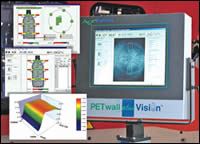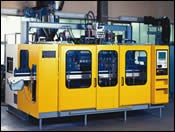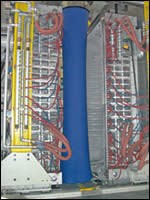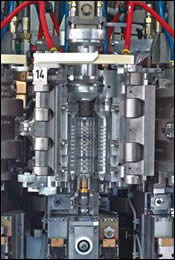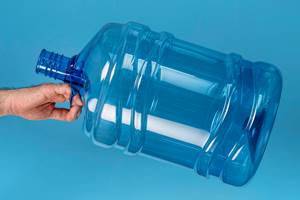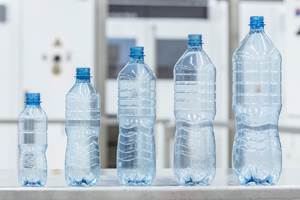K 2004 Wrap-Up on Blow Molding: Outputs Keep Rising For PET, OPP, HDPE
Among the more unusual blow molding developments at K 2004 was a closed-loop control system that monitors and corrects material distribution in PET containers as they are produced.
Among the more unusual blow molding developments at K 2004 was a closed-loop control system that monitors and corrects material distribution in PET containers as they are produced. Also featured were a novel top-and-bottom extrusion blow system, the world's largest coextrusion blow molder, a new deep-grip PET bottle design, the first all-electric reheat stretch-blow molder, and an all-electric extrusion blow unit with automatic carriage-stroke adjustment. (Not covered below are new equipment from Jomar, Novapak, Plastimac, Uniloy Milacron, and Wilmington that appeared in our show preview in September.)
New control tool
AGR TopWave LLC has integrated its PETWall thickness-monitoring system with Virtual Prototyping software from Plastic Technologies Inc. (PTI) to create a closed-loop control system for PET stretch-blow molding. "It's a new window into the blow molder to see how material distribution changes," says Ron Puvak, AGR TopWave's business-development director. "It's a new proactive tool that eliminates manual adjustments."
Several years ago, AGR TopWave and PTI jointly developed the PETWall system, which checks every container during production to quickly spot process variations that affect quality. The system performs vision inspection for flaws, checks wall-thickness distribution, and calculates a shelf-life estimate based on the thickness data. Until now, any process adjustments based on those data had to be done manually. Now, PTI's Virtual Prototyping software analyzes results from the PETWall system, generates an updated set of processing conditions, and gives direct feedback to the molding machine to make any adjustments.
AGR TopWave says the closed-loop system will keep up with production from most PET blow molding machines—up to 70,000 bottles/hr. The system is due to be commercialized in mid-to-late 2005. Although no price was available, a stand-alone PETWall system can cost $80,000 to $100,000 and PTI's Virtual Prototyping software can be licensed for $20,000 to $50,000/yr.
PET pushes the limits
In PET machinery developments, Nissei ASB produced a unique deep-grip 2L bottle utilizing its one-stage, four-station ASB-70DPH stretch-blow unit. The company says this bottle (for edible oil) has a grip about 20 mm deeper than conventional designs, allowing the user to hold it as securely as a full handle. By eliminating the need for a secondary handle, the deep grip is estimated to cut total production costs by 30%.
It has been difficult to produce such a deep, non-through-handle design in PET, according to sales v.p. Robert Hyams. The solution involves both a proprietary mold design and a special conditioning station that includes an added device for temperature adjustment. The preform has to be thick enough to maintain the extra heat needed for blowing out the bottle to the necessary depth. At the show, Nissei molded the 2L bottle in a three-cavity mold on an 18.5-sec cycle at 583 bottles/hr. Target applications include juice, water, and liquor.
Nissei also unveiled the model PF8-4B VK4, a "1.5-stage" injection stretch-blow unit with higher output than the previous PF8-4B model. The machine, which uses a "cool parison" technique, has a dry-cycle time of 3.25 sec compared with 4.5 sec for the previous model. Overall cycle time is 8.7 sec. The machine makes round and non-round containers up to 1.5L with neck diameters up to 38 mm.
Urola S.C. of Spain introduced the URBI 2, which is said to be the first all-electric reheat stretch-blow molding machine. The unit boasts a footprint (8 x 9 ft) about 50% smaller than the previous hydraulic unit. The two-cavity unit features quick mold changes and an oven designed for improved energy efficiency and cost savings from the use of only two heating modules in a shorter oven. The URBI 2 is targeted for water and carbonated soft-drink bottles up to 2L with maximum neck diameter of 38 mm. Output is 3200 bottles/hr vs. 2000/hr on a previous model. Urola is also developing a four-cavity unit.
SIG Corpoplast launched its largest capacity PET machine yet. The Blomax 24 rotary reheat model has 24 blowing stations and can produce up to 43,200 bottles/hr in sizes up to 1.5L. The compact Blomax 24 has the same footprint as the Blomax 20 (20 stations, 30,000/hr) but has significantly greater output. Contributing to higher speed are lighter mold carriers and direct coupling of the movements of the mold base and cavity halves at each station.
Other changes permit 25% faster product changeovers. The longitudinally adjustable stretch rod does not have to be replaced to make a bottle with a different length. A single stretch rod can now be used for all bottle lengths.
SIPA of Italy is developing a new barrier dip-coating technology, called Smart Coat, for PET bottles. The machine maker is working with another Italian company and has set up a pilot production line at its headquarters near Venice. After blowing, the bottles are dip coated and then flash-dried in an infrared oven. Another coating is applied and the bottle is uv cured. The stand-alone dip-coating unit can handle about 12,000 bottles/hr. Shelf life for single-serve 500-cc bottles is said to be a year for coated PET vs. seven weeks for uncoated bottles. Carbonated soft drinks are one target for the new coating, which should be commercial within a year.
New from Krones of Germany is a system that cuts compressed-air use in stretch-blow molding and lowers operating costs. The Air Wizard optimization package of hardware and software targets three areas. It focuses on reducing the volume of dead space, reducing the blowing pressure, and recycling the blowing air.
Modifications enable the volume of the valve block and the blowing nozzles to be downsized from 500 ml to 250 cc. Krones says the process is not altered, since the flow cross sections for the blowing air remain the same. Possible savings in air consumption here are more than 7%. By optimizing the process, the blowing-air pressure can be reduced to suit the bottle requirements and still realize a cost savings for air of up to 25%. Finally, after molding, part of the blowing air in the pressure-relief phase can be used for other functions such as pre-blowing and stretching. This saves up to 25% more in air consumption. Krones estimates that all these upgrades on its Conti form S16 stretch-blow machine can result in total savings of more than $120,000/yr.
OPP challenges PET
Sidel of France set a new benchmark in stretch-blow molding of clear PP bottles. In collaboration with additive maker Milliken Chemical, Sidel showed that clear PP dairy and juice bottles can be stretch blown at speeds of 1500 bottles/hr per cavity—a rate competitive with PET. The breakthrough makes OPP bottles cost-effective for foods and beverages. The resin was a random copolymer PP from Braskem in Brazil that was clarified with Milliken's Millad 3988 and blow molded on Sidel's SBO 8 machine.
Resin optimization, preform design, and machine conditions all played a role in the development, according to Milliken. Sidel and Milliken have signed a collaboration agreement to expand the scope of the technology. Packpet, a Brazilian molder, is debuting the technology for production of 250-cc juice bottles for Tampico, a brand of Tyler Mountain Water Co. in Poca, W.Va.
Extrusion blow news
Bekum demonstrated its new tandem blowing process on a BM-206 shuttle machine. Each of three parisons was pinched off to make two bottles oriented tail to tail, one blown from the top and one from the bottom. This approach not only doubles machine output but is said to have much greater potential than earlier approaches where a single needle was used to blow two bottles oriented neck to neck. That needle-blowing technique could deliver only limited air volumes through the restricted channel. At the show, 14-g, 250-cc HDPE bottles were blown at 3300/hr, which could be doubled on a dual-sided machine. The parison programmer profiled both bottles on each parison. The pairs of bottles were cut apart and trimmed in the machine and placed upright on the exit conveyor.
Bekum also launched the high-capacity BM-806D double-sided shuttle machine. It can run up to 20 cavities of 700-ml bottles and containers up to 10L. Direct-acting hydraulic clamps adjust easily to variable mold thicknesses. The unit also controls the force distribution between the clamp and hydraulic calibration stations so that the calibration force is not directed into the machine frame as in previous complex, heavy, and confining designs. At the show, the machine produced 300-cc HDPE shampoo bottles in 16 cavities at 5760 bottles/hr. Cycle time is 10 sec.
The largest coextrusion blow machine in the world, built by Rikutec of Germany, has been sold to Fralo Plastech Mfg. in Syracuse, N.Y. Fralo will make 1500-gal, four-layer septic tanks weighing 650 lb on Rikutec's model GBM S6000/A 400 coex 4/4 E 140. The machine has a 400-liter accumulator head and 660-ton clamp. The 6-meter-tall mold has an unscrewing device to create the tank's inner thread. The tank measures 4.9 x 3.9 x 15.1 ft and contains two outer layers of virgin HDPE and two inner layers of recycled HDPE. Cycle time is 10 min.
Four 140-mm extruders put out more than 4400 lb/hr of HMW-HDPE. Maximum shot weight is about 770 lb. The four-layer accumulator head accommodates dies with up to 1200 mm diam. The machine is almost 46 ft high, 57 ft wide, and 51 ft deep. It also requires a pit 6.5 ft deep beneath the mold clamp.
Meanwhile, a new mid-size shuttle machine for containers up to 3L was launched by Graham Machinery Group. The Hesta-Graham HFD 490 fills the gap between the smaller single-station HG and the larger double-station HLD series. The HFD 490 has a mold stroke of 490 mm and will be followed next year by the smaller HFD 390 with a 390-mm stroke. The HFD 490 can run up to six cavities and produces 2500 to 3000 bottles/hr. This is the first Hesta-Graham unit to include Graham's new PC controller, the XBM Navigator.
New option for electrics
Magic MP of Italy unveiled a new automatic carriage-stroke adjustment for its all-electric extrusion blow machines. The AVS (automatic variable stroke) feature handles centering adjustments under the parison for producing off-centered necks or bottles with flash outside the neck, which often results in concentricity problems on round bottles. The carriage stroke can be changed without manual intervention, and the blow-pin assembly is adjusted simultaneously to ensure proper mold centering.
The two-station AVS series can run up to six cavities and produce 50-cc bottles at 5250/hr. Bottles and containers up to 1L are targeted for dairy, detergent, and personal-care applications. Magic said that in the future all of its electric machines will carry the AVS option.
Related Content
End-to-End Quality Management For Aseptic PET Beverage Bottling
Sidel introduces Qual-IS comprehensive quality system to merge all QC activities in PET aseptic beverage bottling, from the preform blowing to laboratory management.
Read MoreAll-Electric Shuttle and Stretch-Blow Machines
NPE2024: Meccanoplastica shows off a double-sided shuttle for containers up to 5 L and a reheat stretch-blow molder for up to 2.5 L PET containers with four cavities — both all-electric.
Read MoreStretching the Boundaries of Large PET Containers
NPE2024: Cypet shows off new capabilities for its ISBM machines.
Read MoreFirst Water Bottles With Ultrathin Glass Coating
Long used for sensitive juices and carbonated soft drinks, KHS Freshsafe PET Plasmax vapor-deposited glass coating is now providing freshness and flavor protection for PET mineral water bottles.
Read MoreRead Next
Lead the Conversation, Change the Conversation
Coverage of single-use plastics can be both misleading and demoralizing. Here are 10 tips for changing the perception of the plastics industry at your company and in your community.
Read MoreSee Recyclers Close the Loop on Trade Show Production Scrap at NPE2024
A collaboration between show organizer PLASTICS, recycler CPR and size reduction experts WEIMA and Conair recovered and recycled all production scrap at NPE2024.
Read More


